Publications
Feature Sensitive Surface Extraction from Volume Data
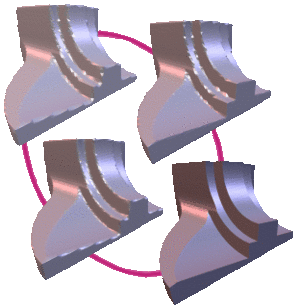
The representation of geometric objects based on volumetric data structures has advantages in many geometry processing applications that require, e.g., fast surface interrogation or boolean operations such as intersection and union. However, surface based algorithms like shape optimization (fairing) or freeform modeling often need a topological manifold representation where neighborhood information within the surface is explicitly available. Consequently, it is necessary to find effective conversion algorithms to generate explicit surface descriptions for the geometry which is implicitly defined by a volumetric data set. Since volume data is usually sampled on a regular grid with a given step width, we often observe severe alias artifacts at sharp features on the extracted surfaces. In this paper we present a new technique for surface extraction that performs feature sensitive sampling and thus reduces these alias effects while keeping the simple algorithmic structure of the standard Marching Cubes algorithm. We demonstrate the effectiveness of the new technique with a number of application examples ranging from CSG modeling and simulation to surface reconstruction and remeshing of polygonal models.
An implementation is available in the Software section.
Feature Sensitive Remeshing

Remeshing artifacts are a fundamental problem when converting a given geometry into a triangle mesh. We propose a new remeshing technique that is sensitive to features. First, the resolution of the mesh is iteratively adapted by a global restructuring process which optimizes the connectivity. Than a particle system approach evenly distributes the vertices across the original geometry. To exactly find the features we extend the relacation procedure by an effective mechanism to attract the vertices to feature edges. The attracting force is imposed by means of a hierarchical curvature field and does not require any tresholding parameters to classify the features.
Resampling Feature and Blend Regions in Polygonal Meshes for Surface Anti-Aliasing
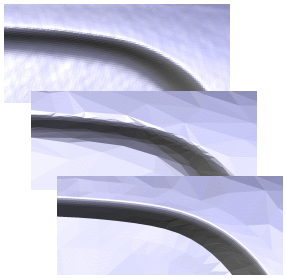
Efficient surface reconstruction and reverse engineering techniques are usually based on a polygonal mesh representation of the geometry: the resulting models emerge from piecewise linear interpolation of a set of sample points. The quality of the reconstruction not only depends on the number and density of the sample points but also on their alignment to sharp and rounded features of the original geometry. Bad alignment can lead to severe alias artifacts. In this paper we present a sampling pattern for feature and blend regions which minimizes these alias errors. We show how to improve the quality of a given polygonal mesh model by resampling its feature and blend regions within an interactive framework. We further demonstrate sophisticated modeling operations that can be implemented based on this resampling technique.
3D Object Recognition from Range Images using Local Feature Histograms
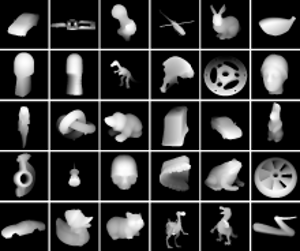
This paper explores a view-based approach to recognize free-form objects in range images. We are using a set of local features that are easy to calculate and robust to partial occlusions. By combining those features in a multidimensional histogram, we can obtain highly discriminant classifiers without the need for segmentation. Recognition is performed using either histogram matching or a probabilistic recognition algorithm. We compare the performance of both methods in the presence of occlusions and test the system on a database of almost 2000 full-sphere views of 30 free-form objects. The system achieves a recognition accuracy above 93% on ideal images, and of 89% with 20% occlusion.
@inproceedings{hetzel20013d,
title={3D Object Recognition from Range Images using Local Feature Histograms}},
author={{Hetzel, G{\"u}nter and Leibe, Bastian and Levi, Paul and Schiele, Bernt}},
booktitle={{Computer Vision and Pattern Recognition, 2001. CVPR 2001. Proceedings of the 2001 IEEE Computer Society Conference on}},
volume={2},
pages={II--394},
year={2001},
organization={IEEE}
}
Local Feature Histograms for Object Recognition from Range Images
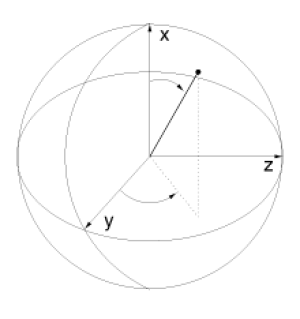
In this paper, we explore the use of local feature histograms for view-based recognition of free-form objects from range images. Our approach uses a set of local features that are easy to calculate and robust to partial occlusions. By combining them in a multidimensional histogram, we can obtain highly discriminative classi ers without having to solve a segmentation problem. The system achieves above 91% recognition accuracy on a database of almost 2000 full-sphere views of 30 free-form objects, with only minimal space requirements. In addition, since it only requires the calculation of very simple features, it is ex- tremely fast and can achieve real-time recognition performance.
@article{leibe2001local,
title={Local feature histograms for object recognition from range images},
author={Leibe, Bastian and Hetzel, G{\"u}nter and Levi, Paul},
year={2001}
}
Integration of Wireless Gesture Tracking, Object Tracking, and 3D Reconstruction in the Perceptive Workbench
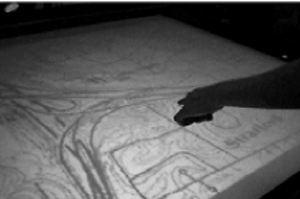
The Perceptive Workbench endeavors to create a spontaneous and unimpeded interface between the physical and virtual worlds. Its vision-based methods for interaction constitute an alternative to wired input devices and tethered tracking. Objects are recognized and tracked when placed on the display surface. By using multiple infrared light sources, the object’s 3D shape can be captured and inserted into the virtual interface. This ability permits spontaneity since either preloaded objects or those objects selected at run-time by the user can become physical icons. Integrated into the same vision-based interface is the ability to identify 3D hand position, pointing direction, and sweeping arm gestures. Such gestures can enhance selection, manipulation, and navigation tasks. In previous publications, the Perceptive Workbench has demonstrated its utility for a variety of applications, including augmented reality gaming and terrain navigation. This paper will focus on the implementation and performance aspects and will introduce recent enhancements to the system.
@incollection{leibe2001integration,
title={{Integration of Wireless Gesture Tracking, Object Tracking, and 3D Reconstruction in the Perceptive Workbench}},
author={{Leibe, Bastian and Minnen, David and Weeks, Justin and Starner, Thad}},
booktitle={{Computer Vision Systems}},
pages={73--92},
year={2001},
publisher={Springer}
}
A Robust Procedure to Eliminate Degenerate Faces from Triangle Meshes
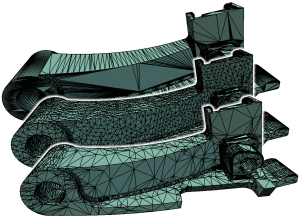
When using triangle meshes in numerical simulations or other sophisticated downstream applications, we have to guarantee that no degenerate faces are present since they have, e.g., no well defined normal vectors. In this paper we present a simple but effective algorithm to remove such artifacts from a given triangle mesh. The central problem is to make this algorithm numerically robust because degenerate triangles are usually the source for all kinds of numerical instabilities. Our algorithm is based on a slicing technique that cuts a set of planes through the given polygonal model. The mesh slicing operator only uses numerically stable predicates and therefore is able to split faces in a controlled manner. In combination with a custom tailored mesh decimation scheme we are able to remove the degenerate faces from meshes like those typically generated by tesselation units in CAD systems.
Previous Year (2000)

